Test Design Techniques: Why You Should Know Them

When you develop software, you expect perfect results and quality that meet your expectations.
But this is not always possible. You can’t just launch a prototype with many bugs and errors because this can negatively impact your business reputation, brand credibility, and user interest in the software or application.
Test design is one of the numerous essential prerequisites for new software quality.
The main issue in test design is that an infinite number of possible tests can be executed. Still, there is never enough time or people to do so. You must carefully set manageable and helpful tests to catch flaws and other quality problems.
We see impressive data in the Global Market Insights study published in September 2021. The software testing market exceeded the dimensions of $40 billion in 2020. However, it is estimated to increase at a more than 7% Compound Annual Growth Rate from 2021 to 2027.

Source: Global Market Insights
The World Quality Report (2021-2022) mentions that 60% of responders said they maximize the automation of tests.
Test design directs the strategy of creating various tests.
Test design techniques allow to form and define enough conditions for testing. One of the test design techniques is suitable for detecting a specific sort of software bug.
The ASD Team knows firsthand how crucial it is to pick the proper test design techniques to catch all possible bugs in a program developed by beginners or even professionals.
If you still have trouble describing test designs, test design techniques, and their digital value, let’s talk about it closely. We propose you read about steps in the design cycle, the main kinds of test design techniques, and their importance.
Let’s go.
How can we define the Test Design Techniques?
For someone unfamiliar or not familiar enough with the categories of software development, it is vital to understand how we can achieve the perfect product and what it takes. We will discuss the testing process and the Test Design Techniques used.
Test Design vs. Test Design Techniques
Test Design and Test Design Techniques are not identical things. Whereas by the first term, we mean creating a plan to realize an intended idea, Test Design Techniques are specific methods or techniques that ASD Team applies to accomplish a task. The idea is to make a platform, application, website, or program work at a level that will allow it to be released to the public. They should have no or few bugs that would turn into a problem for the average user.
Thus, Test Design and Test Design Techniques correlate as a goal and a way to achieve it.
Why are Test Design Techniques essential?
With suitable Test Design Techniques, we can develop good tests that detect all serious and non-serious problems in the software. In addition, it will save human and time resources and minimize the number of tests needed to effectively test the product.
Why does testing have an increased digital value?
Our world is going through a successful digital transformation. Because of this, the market for digital applications and web platforms is highly competitive. You must create a quality product to maintain a high consumer ranking position.
For example, our client was developing a new version of the service to replace a technically outdated one. The client started working on the latest version with another team. Still, they broke deadlines and delivered a product of inadequate quality. The ASD team took responsibility for stabilizing the product and expanding its functionality. Thanks to work done by the ASD Team, the client application has improved performance and many new features.
To create something outstanding, the developer must ensure:
- the smooth operation of the application;
- high performance;
- a decent quality of the product;
- data security.
There is testing and specially selected Test Design Techniques to check how well he has coped with these tasks.
What are the 6 steps in the Design Process?
Creating a good product requires several steps, from defining the problem to be solved to prototyping, testing, and fixing bugs. Let’s peek at each of these stages.

Step 1: Define the challenge
The most critical mission is to determine what you face to solve any challenge. To do this, the ASD team determines:
- What are the goals of the project?
- Who will be the product user, and for whom is it designed?
- What pain should this product solve?
- What are the criteria for measuring success?
- Are there competitors and similar products on the market?
- How should this product be different from and superior to competitors’ offerings?
Step 2: Research
After determining the scope and area of work, we conduct market research on similar products. ASD team does it to get the necessary information to create a masterpiece.
- Looking at your competitor’s products, we address the following questions:
- Why would a consumer choose your product?
- Where do users generally buy similar products?
- What modifications would make an existing outcome better serve the user?
Step 3: Imagine
When we have gathered the basis for the software development, the ASD team conducts a real brainstorming to create a product that complies with all client’s requirements. Here we make the main idea we will realize in the next step.
Step 4: Create a Prototype
To find the weak point, we develop a prototype. It works well in software development. Once we get feedback on the effectiveness of the prototype, we have the opportunity to improve it using other Test Design Techniques and make it more efficient.
Step 5: Testing
It is a mandatory and necessary step. It is responsible for identifying all possible bugs that can make users lose their desire to use your product. We select Test Design Techniques that will lead to the expected result – a development that satisfies consumer needs. At this step, we create a test capable of identifying all the defects in the software. Testing allows you to improve the prototype as often as possible to create the perfect product, enter the market and get success.
Step 6: Final product
Once we have considered all the corrections and updated the inaccuracies, the ASD team creates a perfect product. We found all bugs in the application, software, or other product based on the test developed using the correct Test Design Techniques. It will be possible to optimize the product for the target user and fix the bugs having received the test results. And the final product is done.
A responsible attitude to the challenges posed to ASD team by the client always leads to an effective result.
You can catch it in the following example.
All system tests of our client’s system used to be carried out manually. It caused many problems, including the high cost of the testers’ team support and the low quality of testing resulting in missed bugs.
Our experts found more than 5,000 bugs of different complexity. The number of critical bugs real users could find was reduced to 0. The number of defects in business functionality decreased by 4 times.
As a result of our work, the client reduced the cost of system maintenance, increased customer loyalty, and increased its market share.
What are the main 3 types of Test Design Techniques?
The test design techniques help us choose a good set of tests from the total number of all possible tests for a given system. There are many different testing methods, each with its strengths and weaknesses. Each individual technique is good at finding specific types of bugs and relatively bad at finding other types.
While specific techniques are better suited for use at the integration level of testing, others are better suited for system or acceptance testing levels.
All techniques can be divided into static and dynamic, where the first refers to human manual testing without automatic tools.
The dynamic testing method refers to the way of verifying the functionality of an application by executing code. This means testing is done with the application and checks how much the functionality meets the expectations.
The dynamic type, in turn, can be divided into Black-box (or Specification-Based) Techniques, White-box (or Structure-Based) Techniques, and Experienced-box Techniques. Let’s consider the characteristics and advantages of each of them.
Black-box Techniques
Such testing methods treat the object to be tested as a black box. This black box has only inputs and outputs, and the tester knows nothing about how the box is arranged inside. Here we are analyzing more of what the software does, not how.
Using Black-box Techniques is based on risk assessment, client requirements, type of system under test, and time and budget limitations.
There are numerous ways for specification-based testing. These methods focus on various software, system, and scenario kinds. The following paragraphs include a short summary of each technique.
So, specification-Based techniques include:
Equivalence Partitioning. It is a test design technique in which test cases are designed to execute representatives from equivalence partitions. Test cases should cover each section at least once. This technique is the most typically operated.
Boundary Value Analysis. It is a method of designing black box tests where test cases are created using boundary values.
Combinatorial Test Technique. The explicit goal of this method is to create combinations of input criteria based on one of the existing algorithms. It is a technique for selecting an appropriate selection of test combinations.
Decision Table Testing. It is a method of creating black box tests where test cases are made to run the combinations of inputs or causes displayed in a decision table.
Classification Tree Method. This technique uses visualization of all test-relevant aspects (aspects that affect the behavior of the test object) in the form of a tree with a clear hierarchy.
State Transition Testing. It is a black-box test method in which test cases are designed to execute invalid and valid state transitions. It is based on the idea of states and final-state machines. The idea of states allows the tester to view the software in terms of its states, transitions between shapes, and the events that trigger state changes.
Cause-Effect Graphing. It is a method of designing black-box tests where test cases are created from cause-and-effect graphs.
Random Testing. The central concept of this technique is to choose random inputs from the possible values for a particular functionality. So there isn’t any system for determining input data. It is also known as random-input testing.
Use Case Testing. Here test cases are designed to execute scenarios of use cases.
White-box Techniques
It is a software testing method that tests an application’s internal structures or operation instead of its functionality (i.e., black box testing). White-box testing uses an internal system perspective to develop tests. The tester selects the input data to run paths through the code and determine the expected output data.
Statement Testing. This technique has the lowest coverage level when the “statement” is chosen as the coverage item. The statement is an entity in a programming language, typically the smallest indivisible unit of execution).
Decision Testing. It is a black-box testing method. It aims to ensure that each one of the possible branches from each decision point is executed at least once, thereby ensuring that all reachable code is completed).
Condition Testing. It is another structural testing technique that is beneficial for unit testing. This method uses source code or pseudocode as a guide for test design.
Data Flow Testing. It is a family of test strategies based on selecting paths through the program’s control flow to analyze sequences of events connected to the status of variables or data objects.
Experienced-box Techniques
In experience-based techniques, people’s skills, knowledge, and experience are central to test execution. The experience of experts is crucial because they can express different points of view in the testing process. They already have the knowledge behind them and can predict what can go wrong. These methods are based on people’s experience, knowledge of the system, and possible defects. The creation of test cases occurs less systematically, but they are no less compelling.
Error Guessing. In this test design method, the tester’s experience is used to anticipate what defects may be present in the element or system under test due to errors and to develop tests specifically to identify them.
Checklist-based testing. It is a technique for test design based on experience in which the experienced tester employs a high-level checklist of items to be noted, reviewed, or remembered or a set of guidelines or standards to which a product must be validated.
Bottom Line
To summarize, you should remember the following Test Design Techniques:
- Black-box Techniques
- White-box Techniques
- Experienced-box Techniques.
Choosing which techniques to apply is one crucial step in the design process that will directly affect test performance.
With the details provided in this piece, you can control the effectiveness of applying the test to your product.
We tried to tell you in simple language about the complex categories of Test Design and Test Design Techniques. We hope you now catch the significance of professionals working to improve the quality and testing of your application or software.
The best solution with ASD Team
ASD Team quality assurance specialists join the web development team from day one. We aim to build a professional and holistic approach to quality assurance. ASD team ensures that your big data trading platform, transportation management system, online food delivery service, a marketplace for small businesses work perfectly. It should have no bugs on all devices, browsers, and screens, under any load, and in any environment.
Working with an ASD team minimizes the risk of customer dissatisfaction with your product, dramatically reduces time to market, and even improves the outcome.
FAQ
Why are test design techniques used?
Well-chosen test design techniques are critical to improving the quality of the software testing process. It helps improve the overall quality and efficiency of the software or platform. In addition, the risk of bugs being detected after the product is released to the market is reduced.
What are manual testing techniques?
Manual testing is a procedure to find problems without automation tools or scripts.
A test plan document is created to ensure that every aspect of the testing process is covered.
Which testing is best?
There are several significant distinctions between automation testing and manual testing. A human executes the tests manually, step by step, without the aid of test scripts during manual testing. Test automation frameworks and additional tools and software are used to automatically perform tests during automated testing.
Who runs the testing makes the most significant distinction between human and automated testing.
The significant advantage of automation testing over manual testing is that you may complete more tests in a shorter amount of time. It boosts output and broadens the scope of your testing.
What is sanity testing?
Common sense testing is a type of regression testing used for quality assurance. It determines whether modules in an existing software build are stable enough to move on to the next testing stage. The goal is to confirm the rationality of the application before proceeding to additional testing.